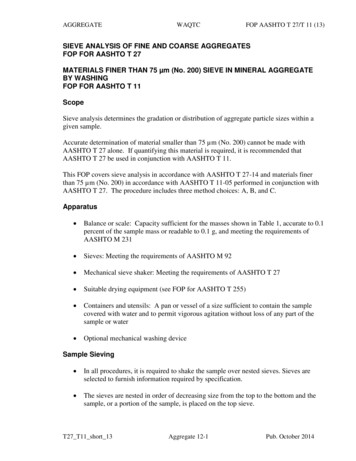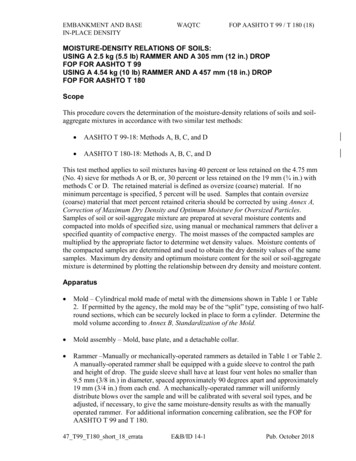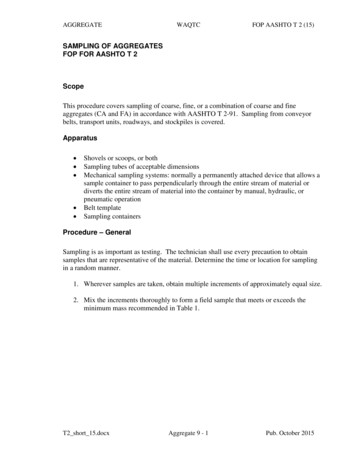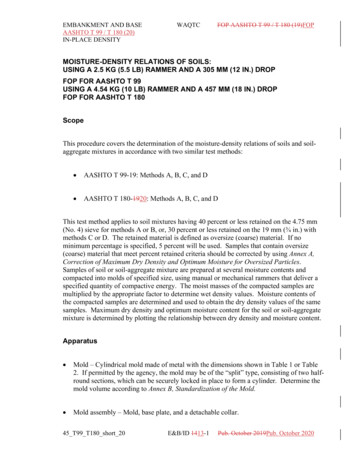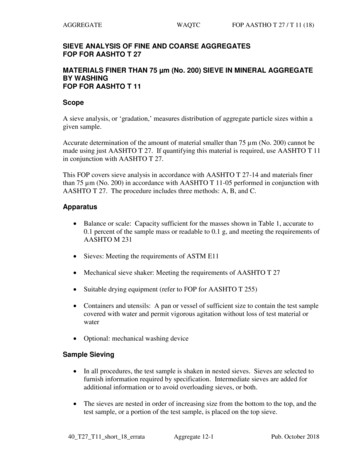
Transcription
AGGREGATEWAQTCFOP AASTHO T 27 / T 11 (18)SIEVE ANALYSIS OF FINE AND COARSE AGGREGATESFOP FOR AASHTO T 27MATERIALS FINER THAN 75 µm (No. 200) SIEVE IN MINERAL AGGREGATEBY WASHINGFOP FOR AASHTO T 11ScopeA sieve analysis, or ‘gradation,’ measures distribution of aggregate particle sizes within agiven sample.Accurate determination of the amount of material smaller than 75 µm (No. 200) cannot bemade using just AASHTO T 27. If quantifying this material is required, use AASHTO T 11in conjunction with AASHTO T 27.This FOP covers sieve analysis in accordance with AASHTO T 27-14 and materials finerthan 75 µm (No. 200) in accordance with AASHTO T 11-05 performed in conjunction withAASHTO T 27. The procedure includes three methods: A, B, and C.Apparatus Balance or scale: Capacity sufficient for the masses shown in Table 1, accurate to0.1 percent of the sample mass or readable to 0.1 g, and meeting the requirements ofAASHTO M 231 Sieves: Meeting the requirements of ASTM E11 Mechanical sieve shaker: Meeting the requirements of AASHTO T 27 Suitable drying equipment (refer to FOP for AASHTO T 255) Containers and utensils: A pan or vessel of sufficient size to contain the test samplecovered with water and permit vigorous agitation without loss of test material orwater Optional: mechanical washing deviceSample Sieving In all procedures, the test sample is shaken in nested sieves. Sieves are selected tofurnish information required by specification. Intermediate sieves are added foradditional information or to avoid overloading sieves, or both. The sieves are nested in order of increasing size from the bottom to the top, and thetest sample, or a portion of the test sample, is placed on the top sieve.40 T27 T11 short 18 errataAggregate 12-1Pub. October 2018
AGGREGATEWAQTCFOP AASTHO T 27 / T 11 (18) The loaded sieves are shaken in a mechanical shaker for approximately 10 minutes,refer to Annex A; Time Evaluation. Care must be taken so that sieves are not overloaded, refer to Annex B; OverloadDetermination. The test sample may be sieved in increments and the mass retainedfor each sieve added together from each test sample increment to avoid overloadingsieves.Sample PreparationObtain samples according to the FOP for AASHTO R 90 and reduce to test sample size,shown in Table 1, according to the FOP for AASHTO R 76.TABLE 1Test Sample Sizes for Aggregate Gradation TestNominal MaximumSize* mm (in.)125 (5)100 (4)90 (3 1/2)75 (3)63 (2 1/2)50 (2)37.5 (1 1/2)25.0 (1)19.0 (3/4)12.5 (1/2)9.5 (3/8)6.3 (1/4)4.75 (No. 4)Minimum Dry Massg (lb)300,000 (660)150,000 (330)100,000 (220)60,000 (130)35,000 (77)20,000 (44)15,000 (33)10,000 (22)5000 (11)2000 (4)1000 (2)1000 (2)500 (1)*Nominal maximum size: One sieve larger than the first sieve to retain more than 10 percent of thematerial using an agency specified set of sieves based on cumulative percent retained. Where largegaps between specification sieves exist, intermediate sieve(s) may be inserted to determine nominalmaximum size.Test sample sizes in Table 1 are standard for aggregate sieve analysis, due to equipmentrestraints samples may need to be divided into several “subsamples.” For example, agradation that requires 100 kg (220 lbs.) of material would not fit into a large tray shaker allat once.Some agencies permit reduced test sample sizes if it is proven that doing so is not detrimentalto the test results. Some agencies require larger test sample sizes. Check agency guidelinesfor required or permitted test sample sizes.40 T27 T11 short 18 errataAggregate 12-2Pub. October 2018
AGGREGATEWAQTCFOP AASTHO T 27 / T 11 (18)Selection of ProcedureAgencies may specify which method to perform. If a method is not specified, performMethod A.OverviewMethod A Determine dry mass of original test sample Wash over a 75µm (No. 200) sieve Determine dry mass of washed test sample Sieve washed test sample Calculate and report percent retained and passing each sieveMethod B Determine dry mass of original test sample Wash over a 75µm (No. 200) sieve Determine dry mass of washed test sample Sieve test sample through coarse sieves, 4.75 mm (No. 4) sieves and larger Determine dry mass of fine material, minus 4.75 mm (No. 4) Reduce fine material Determine mass of reduced portion Sieve reduced portion Calculate and report percent retained and passing each sieveMethod C Determine dry mass of original test sample Sieve test sample through coarse sieves, 4.75 mm (No. 4) sieves and larger Determine mass of fine material, minus 4.75 mm (No. 4) Reduce fine material Determine mass of reduced portion Wash reduced portion over a 75µm (No. 200) sieve Determine dry mass of washed reduced portion Sieve washed reduced portion Calculate and report percent retained and passing each sieve40 T27 T11 short 18 errataAggregate 12-3Pub. October 2018
AGGREGATEWAQTCFOP AASTHO T 27 / T 11 (18)Procedure Method A1. Dry the test sample to constant mass according to the FOP for AASHTO T 255. Cool toroom temperature. Determine and record the total dry mass of the sample to the nearest0.1 percent or 0.1 g. Designate this mass as M.When the specification does not require the amount of material finer than 75 µm(No. 200) be determined by washing, skip to Step 11.2. Nest a sieve, such as a 2.0 mm (No. 10), above the 75 µm (No. 200) sieve.3. Place the test sample in a container and cover with water.Note 1: A detergent, dispersing agent, or other wetting solution may be added to the water to assure athorough separation of the material finer than the 75 µm (No. 200) sieve from the coarser particles.There should be enough wetting agent to produce a small amount of suds when the sample is agitated.Excessive suds may overflow the sieves and carry material away with them.4. Agitate vigorously to ensure complete separation of the material finer than 75 µm(No. 200) from coarser particles and bring the fine material into suspension above thecoarser material. Avoid degradation of the sample when using a mechanical washingdevice.5. Immediately pour the wash water containing the suspended material over the nestedsieves; be careful not to pour out the coarser particles or over fill the 75 µm (No. 200)sieve.6. Add water to cover material remaining in the container, agitate, and repeat Step 5.Continue until the wash water is reasonably clear.7. Remove the upper sieve and return material retained to the washed test sample.8. Rinse the material retained on the 75 µm (No. 200) sieve until water passing through thesieve is reasonably clear and detergent or dispersing agent is removed, if used.9. Return all material retained on the 75 µm (No. 200) sieve to the container by rinsing intothe washed sample.Note 2: Excess water may be carefully removed with a bulb syringe; the removed water must be dischargedback over the 75 µm (No. 200) sieve to prevent loss of fines.10. Dry the washed test sample to constant mass according to the FOP for AASHTO T 255.Cool to room temperature. Determine and record the dry mass.11. Select sieves required by the specification and those necessary to avoid overloading.With a pan on bottom, nest the sieves increasing in size starting with the 75 µm(No. 200).40 T27 T11 short 18 errataAggregate 12-4Pub. October 2018
AGGREGATEWAQTCFOP AASTHO T 27 / T 11 (18)12. Place the test sample, or a portion of the test sample, on the top sieve. Sieves mayalready be in the mechanical shaker, if not place sieves in mechanical shaker and shakefor the minimum time determined to provide complete separation for the sieve shakerbeing used (approximately 10 minutes, the time determined by Annex A).Note 3: Excessive shaking (more than 10 minutes) may result in degradation of the sample.13. Determine and record the individual or cumulative mass retained for each sieve and in thepan. Ensure that all material trapped in full openings of the sieve are removed andincluded in the mass retained.Note 4: For sieves 4.75 mm (No. 4) and larger, check material trapped in less than a full opening by sievingover a full opening. Use coarse wire brushes to clean the 600 µm (No. 30) and larger sieves, and softbristle brushes for smaller sieves.Note 5: In the case of coarse / fine aggregate mixtures, distribute the minus 4.75 mm (No. 4) among two ormore sets of sieves to prevent overloading of individual sieves.14. Perform the Check Sum calculation – Verify the total mass after sieving agrees with thedry mass before sieving to within 0.3 percent. The dry mass before sieving is the drymass after wash or the original dry mass (M) if performing the sieve analysis withoutwashing. Do not use test results for acceptance if the Check Sum result is greater than0.3 percent.15. Calculate the total percentages passing, and the individual or cumulative percentagesretained to the nearest 0.1 percent by dividing the individual sieve masses or cumulativesieve masses by the total mass of the initial dry sample (M).16. Report total percent passing to 1 percent except report the 75 µm (No. 200) sieve to0.1 percent.40 T27 T11 short 18 errataAggregate 12-5Pub. October 2018
AGGREGATEWAQTCFOP AASTHO T 27 / T 11 (18)Method A CalculationsCheck Sum𝐶𝐶ℎ𝑒𝑒𝑒𝑒𝑒𝑒 𝑆𝑆𝑆𝑆𝑆𝑆 𝑑𝑑𝑑𝑑𝑑𝑑 𝑚𝑚𝑚𝑚𝑚𝑚𝑚𝑚 𝑏𝑏𝑏𝑏𝑏𝑏𝑏𝑏𝑏𝑏𝑏𝑏 ��𝑠 𝑡𝑡𝑡𝑡𝑡𝑡𝑡𝑡𝑡𝑡 𝑚𝑚𝑚𝑚𝑚𝑚𝑚𝑚 𝑎𝑎𝑎𝑎𝑎𝑎𝑎𝑎𝑎𝑎 ��𝑠 100𝑑𝑑𝑑𝑑𝑑𝑑 𝑚𝑚𝑚𝑚𝑚𝑚𝑚𝑚 𝑏𝑏𝑏𝑏𝑏𝑏𝑏𝑏𝑏𝑏𝑏𝑏 ��𝑠Percent Retained𝐼𝐼𝐼𝐼𝐼𝐼 𝐼𝐼𝐼𝐼𝐼𝐼 � 𝐶𝐶𝐶𝐶𝐶𝐶 100𝑀𝑀Where:IPR Individual Percent RetainedCPR Cumulative Percent RetainedM Total Dry Sample mass before washingIMR Individual Mass RetainedCMR Cumulative Mass RetainedPercent Passing (PP)𝑃𝑃𝑃𝑃 𝑃𝑃𝑃𝑃𝑃𝑃 𝐼𝐼𝐼𝐼𝐼𝐼Where:40 T27 T11 short 18 errata𝑜𝑜𝑜𝑜𝑃𝑃𝑃𝑃 100 𝐶𝐶𝐶𝐶𝐶𝐶PP Percent PassingPPP Previous Percent PassingAggregate 12-6Pub. October 2018
AGGREGATEWAQTCFOP AASTHO T 27 / T 11 (18)Method A Example Individual Mass RetainedDry mass of total sample before washing (M):5168.7 gDry mass of sample after washing:4911.3 gTotal mass after sieving equalsSum of Individual Masses Retained (IMR),including minus 75 µm (No. 200) in the pan:4905.9 gAmount of 75µm (No. 200) minus washed out (5168.7 g – 4911.3 g):257.4 gCheck Sum𝐶𝐶ℎ𝑒𝑒𝑒𝑒𝑒𝑒 𝑆𝑆𝑆𝑆𝑆𝑆 4911.3 𝑔𝑔 4905.9 𝑔𝑔 100 0.1%4911.3 𝑔𝑔The result is less than 0.3 percent therefore the results can be used for acceptance purposes.Individual Percent Retained (IPR) for 9.5 mm (3/8 in.) sieve:𝐼𝐼𝐼𝐼𝐼𝐼 619.2 𝑔𝑔 100 12.0%5168.7 𝑔𝑔Percent Passing (PP) 9.5 mm (3/8 in.) sieve:𝑃𝑃𝑃𝑃 86.0% 12.0% 74.0%Reported Percent Passing 74%40 T27 T11 short 18 errataAggregate 12-7Pub. October 2018
AGGREGATEWAQTCFOP AASTHO T 27 / T 11 (18)Method A IndividualGradation on All SievesSieve Sizemm ne IPRDivide IMR by Mand multiply by100IndividualPercentRetained(IPR)Determine PPby subtractingIPR fromPrevious PP0724.712.5100.0 14.0 724.714.0 100 (1/2)5168.7619.29.586.0 12.0 619.212.0 100 (3/8)5168.71189.84.7574.0 23.0 1189.823.0 100 (No. 4)5168.7877.62.3651.0 17.0 877.617.0 100 (No. 8)5168.7574.81.1834.0 11.1 574.811.1 100 (No. 16)5168.7329.80.60022.9 6.4 329.86.4 100 (No. 30)5168.7228.50.30016.5 4.4 228.54.4 100 (No. 50)5168.7205.70.15012.1 4.0 205.74.0 100 (No. 100)5168.7135.70.0758.1 2.6 135.42.6 100 (No. 200)5168.7minus 0.075(No. 200)20.4in the panTotal mass after sieving sum of sieves mass in the pan 4905.9 gDry mass of total sample, before washing (M): 185.55.5* Report total percent passing to 1 percent except report the 75 µm (No. 200) sieve to 0.1 percent.40 T27 T11 short 18 errataAggregate 12-8Pub. October 2018
AGGREGATEWAQTCFOP AASTHO T 27 / T 11 (18)Method A Example Cumulative Mass RetainedDry mass of total sample before washing (M):5168.7 gDry mass of sample after washing:4911.3 gTotal mass after sieving equals Final Cumulative Mass Retained(FCMR) (includes minus 75 µm (No. 200) from the pan):4905.9 gAmount of 75µm (No. 200) minus washed out (5168.7 g – 4911.3 g):257.4 gCheck Sum𝐶𝐶ℎ𝑒𝑒𝑒𝑒𝑒𝑒 𝑆𝑆𝑆𝑆𝑆𝑆 4911.3 𝑔𝑔 4905.9 𝑔𝑔 100 0.1%4911.3 𝑔𝑔The result is less than 0.3 percent therefore the results can be used for acceptance purposes.Cumulative Percent Retained (CPR) for 9.5 mm (3/8 in.) sieve:𝐶𝐶𝐶𝐶𝐶𝐶 1343.9 𝑔𝑔 100 26.0%5168.7 𝑔𝑔Percent Passing (PP) 9.5 mm (3/8 in.) sieve:𝑃𝑃𝑃𝑃 100.0% – 26.0% 74.0%Reported Percent Passing 74%40 T27 T11 short 18 errataAggregate 12-9Pub. October 2018
AGGREGATEWAQTCFOP AASTHO T 27 / T 11 (18)Method A CumulativeGradation on All SievesSieve Sizemm (in.)19.0(3/4)12.5(1/2)9.5(3/8)4.75(No. 4)2.36(No. 8)1.18(No. 16)0.600(No. 30)0.300(No. 50)0.150(No. 100)0.075(No. 200)FCMRCumulativeMassRetainedg(CMR)Determine CPRDivide CMR byM and multiplyby ne PPby subtractingCPR from 0100100.0 14.0 86.086100.0 26.0 74.074100.0 49.0 51.051100.0 66.0 34.034100.0 77.1 22.923100.0 83.5 16.517100.0 87.9 12.112100.0 91.9 8.18100.0 94.5 5.55.50.0724.7 100 5168.71343.9 100 5168.72533.7 100 5168.73411.3 100 5168.73986.1 100 5168.74315.9 100 5168.74544.4 100 5168.74750.1 100 5168.74885.5 100 5168.714.026.049.066.077.183.587.991.994.5Total mass after sieving: 4905.9 gDry mass of total sample, before washing (M): 5168.7 g* Report total percent passing to 1 percent except report the 75 µm (No. 200) sieve to 0.1 percent.40 T27 T11 short 18 errataAggregate 12-10Pub. October 2018
AGGREGATEWAQTCFOP AASTHO T 27 / T 11 (18)Procedure Method B1. Dry the test sample to constant mass according to the FOP for AASHTO T 255. Cool toroom temperature. Determine and record the total dry mass of the sample to the nearest0.1 percent or 0.1 g. Designate this mass as M.When the specification does not require the amount of material finer than 75 µm(No. 200) be determined by washing, skip to Step 11.2. Nest a protective sie
FOP FOR AASHTO T 11 . Scope . A sieve analysis, or ‘gradation,’ measures distribution of aggregate particle sizes within a given sample. Accurate determination of the amount of material smaller than 75 µm (No. 200) cannot be made using just AASHTO T 27. If quantifying this material is required, use AASHTO T 11 in conjunction with AASHTO T 27.File Size: 311KBPage Count: 40
